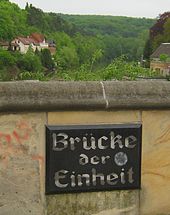Peace stones
Coordinates: 51 ° 8 ′ 19.68 " N , 11 ° 42 ′ 44.21" E
The peace stones in Bad Kösen are a monument to the history of Prussian-German unification in the 19th century.
Location and importance
The four peace stones are located in Bad Kösen above the Ilskeweg on the steep slope towards Fränkenau . The limestone is roughly carved on the front and has dates carved into it. Arranged tightly next to each other and in an arch, three stones remind of the peace treaties after the German Wars of Unification . In front of it there is a fourth stone for the Second Peace of Paris . When and by whom the stones were donated is still unknown. Until 2001, no documents or newspaper reports were found in the Kösener and Naumburg archives. Bruno Schmidt, landlord in Kukulau and member of the Kosen Bathing Commission, took care of the stones at the end of the 19th century. There is much to suggest that he also donated and set it up.
1864 Vienna
The left stone refers to the Peace of Vienna . The year 1864 can still be seen . Originally, the information was complete on October 30, 1864 . On that day Prussia , Austria and Denmark made peace after the (second) German-Danish War . In the dispute over the duchies of Schleswig, Holstein and Lauenburg, with the death of the Danish King Friedrich VII in November 1863, relations between states in Europe intensified. The successor to Christian IX. had changed the special position of the duchies insofar as he had separated Schleswig from Holstein by the November constitution and incorporated it into his kingdom. After the federal execution against the duchies of Holstein and Lauenburg in 1863 , Prussia ultimately demanded that Denmark be repealed; otherwise Schleswig would be occupied. As Christian IX. refused, the invasion of the allies began on February 1, 1864. After initial failures, Prussia achieved the decisive victory at the Düppeler Schanzen .
1866 Prague
The right stone relates to the Peace of Prague (1866) . The date 23 AUGUST 1866 is clearly legible . Otto von Bismarck had planned the argument for a long time. The cause was the unresolved Schleswig-Holstein question . Austria had tried unauthorized to implement its proposals in the Bundestag (German Confederation) . This prompted Prussia to invade Holstein and break the German Federal Act . A declaration of war on Austria was the result. In the German War Bavaria, Hanover, Saxony, Württemberg, Baden, Hessen-Darmstadt, Hessen-Kassel, Nassau and a few smaller states sided with Austria. The north German small and medium-sized states and Italy, with which a secret alliance had existed since April 1866, held on to Prussia. Helmut von Moltke achieved the decisive victory in the battle of Königgrätz .
1871 Frankfurt a. M.
The middle stone is dated 10 MAY 1871 . After the Franco-German War and the German Empire sealed the Treaty of Frankfurt , the German unification . France declared war on Prussia on July 19, 1870. The powerful North German Confederation was perceived by France as a threat. Prussia came in handy because it wanted to strengthen its position in Germany and could call a national war. After heavy fighting in Alsace and Lorraine , Moltke achieved the decisive victory in the Battle of Sedan . Napoleon III was captured and the Second Empire overthrown. The surrender was imminent, but the Provisional National Government (from which the Third French Republic emerged ) rejected the terms of the surrender. They organized a people's war against the invaders. Only after several lost battles and the fall of Paris did she find herself ready for the preliminary peace of Versailles . Wilhelm I was proclaimed German Emperor in Versailles . The German Empire was founded. After lengthy negotiations in Brussels and Frankfurt, the peace was concluded on May 10, 1871 in Frankfurt's Hotel zum Schwan .
1815 Paris
In front of these three stones there is a rectangular, also roughly cut boulder with the inscription NOVEMBER 20, 1815 . On that day, Friedrich Wilhelm III. , Franz I and Alexander I the Second Peace of Paris . Napoleon's reign of the Hundred Days had come to an end in the battle of Belle Alliance (Waterloo). The power struggle between Prussia and Austria began in the German Confederation .
See also

- peace contract
- List of cultural monuments in Naumburg (Saale) / districts: Bad Kösen
- List of Important Peace Deals: Modern History (1789 to 1900)
- War memorials in 1864, 1866 and 1870/71
literature
- Klaus-Dieter Fichtner : Peace stones in the cave near Bad Kösen. Monuments are reminiscent of three wars on German soil - guesswork about the founder of the stones - horticultural repairs desirable . Naumburger Tageblatt of September 22, 2001.
Web links
Individual evidence
- ↑ Naumburg Monument List (2018)
- ↑ K.-D. Fichtner: The peace stones in the cave near Bad Kösen . Mitteldeutsche Zeitung, Vol. 12 (2001), 222, p. 21
- ^ History of Bad Kösen
- ^ Kösener sponsors of the Rudelsburg (VfcG)




